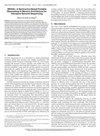AiDE: Attention-FFN Disaggregated Execution for Cost-Effective LLM Decoding on CXL-PNM
IF 1.4
3区 计算机科学
Q4 COMPUTER SCIENCE, HARDWARE & ARCHITECTURE
引用次数: 0
Abstract
Disaggregating the prefill and decode phases has recently emerged as a promising strategy in the large language model (LLM) serving systems, driven by the distinct resource demands of each phase. Inspired by this coarse-grained disaggregation, we identify a similar opportunity within the decode phase itself: the feedforward network (FFN) is compute-intensive, whereas attention is constrained by memory bandwidth and capacity due to its key-value (KV) cache. To exploit this heterogeneity, we introduce AiDE, a heterogeneous decoding cluster that executes FFN operations on GPUs while offloading attention computations to Compute Express Link-based Processing Near Memory (CXL-PNM) devices. CXL-PNM provides scalable memory bandwidth and capacity, making it well-suited for attention-heavy workloads. In addition, we propose a batch-level pipelining approach enhanced with request scheduling to optimize the utilization of heterogeneous resources. Our AiDE architecture achieves up to 3.87× higher throughput, 2.72× lower p90 time per output token (TPOT), and a 2.31× reduction in decode latency compared to a GPU-only baseline, at comparable cost, demonstrating significant potential of fine-grained disaggregation for cost-effective LLM inference.基于CXL-PNM的低成本LLM译码的注意- ffn分解执行
分解预填充和解码阶段最近在大型语言模型(LLM)服务系统中成为一种很有前途的策略,这是由每个阶段不同的资源需求驱动的。受这种粗粒度分解的启发,我们在解码阶段本身中发现了类似的机会:前馈网络(FFN)是计算密集型的,而由于其键值(KV)缓存,注意力受到内存带宽和容量的限制。为了利用这种异质性,我们引入了AiDE,这是一种异构解码集群,它在gpu上执行FFN操作,同时将注意力计算卸载到Compute Express基于链路的处理近内存(CXL-PNM)设备上。CXL-PNM提供可扩展的内存带宽和容量,使其非常适合注意力密集的工作负载。此外,我们提出了一种增强请求调度的批处理级流水线方法,以优化异构资源的利用。与仅使用gpu的基准相比,我们的AiDE架构实现了高达3.87倍的高吞吐量,2.72倍的低p90时间(TPOT),以及2.31倍的解码延迟减少,成本相当,证明了细粒度分解在经济高效的LLM推理中的巨大潜力。
本文章由计算机程序翻译,如有差异,请以英文原文为准。
求助全文
约1分钟内获得全文
求助全文
来源期刊

IEEE Computer Architecture Letters
COMPUTER SCIENCE, HARDWARE & ARCHITECTURE-
CiteScore
4.60
自引率
4.30%
发文量
29
期刊介绍:
IEEE Computer Architecture Letters is a rigorously peer-reviewed forum for publishing early, high-impact results in the areas of uni- and multiprocessor computer systems, computer architecture, microarchitecture, workload characterization, performance evaluation and simulation techniques, and power-aware computing. Submissions are welcomed on any topic in computer architecture, especially but not limited to: microprocessor and multiprocessor systems, microarchitecture and ILP processors, workload characterization, performance evaluation and simulation techniques, compiler-hardware and operating system-hardware interactions, interconnect architectures, memory and cache systems, power and thermal issues at the architecture level, I/O architectures and techniques, independent validation of previously published results, analysis of unsuccessful techniques, domain-specific processor architectures (e.g., embedded, graphics, network, etc.), real-time and high-availability architectures, reconfigurable systems.
 求助内容:
求助内容: 应助结果提醒方式:
应助结果提醒方式:


